Hortus sanitatis
Hortus sanitatis ou Ortus sanitatis est le nom d'un herbier en latin, publié en juin 1491 à Mainz par Jacob Meydenbach. De même que l‘herbier en latin Herbarius moguntinus (imprimé par Peter Schöffer, 1484) et l’herbier en allemand Gart der Gesundheit (écrit par Johann Wonnecke von Kaub; imprimé par Peter Schöffer, 1485) le Hortus sanitatis appartient au Groupe des herbiers-incunables de Mayence.
Auteur
L'auteur est inconnu. Parfois, Johann Wonnecke von Kaub est nommé à tort comme l'auteur.
Contenu
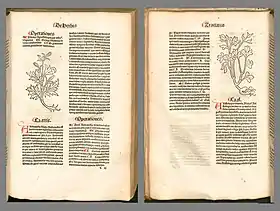
Le texte est mis à imprimer sur deux colonnes.
Il est divisé en cinq sections, dans lesquelles les substances utilisées pour la thérapie sont décrites :
- De Herbis avec 530 chapitres sur les herbes.
- De Animalibus avec 164 chapitres sur les animaux terrestres (1er chapitre: De homo).
- De Avibus avec 122 chapitres sur les oiseaux et autres animaux volants.
- De Piscibus avec 106 chapitres sur les animaux aquatiques.
- De Lapidibus avec 144 chapitres sur les pierres semi-précieuses, les minerais et les minéraux.
- Un traité sur l’uroscopie et plusieurs registres détaillés forment la conclusion.
Sources
Le Hortus sanitatis est une compilation d'après des encyclopédies médiévales bien connues, par exemple d'après le Liber pandectarum medicinae omnia medicine simplicia continens de Matthaeus Silvaticus (14ème siècle) et d'après le Speculum naturale de Vincent de Beauvais (13ème siècle)[1] - [2] - [3]
Éditions
Incunables (estampes du XVe siècle)
Post-incunable(XVIe siècle)
- Strasbourg après 1500[7]
- Avec des gravures sur bois de l'atelier de Hans Grüninger.
- Venise (Bernhardinus Benalius et Johannes de Cereto de Tridino) 1511
- 4ème réimpression : Venise 1611 ; Réimpression (en deux volumes) Würzburg 1978.
- Strasbourg 1517[8]
Sections deux à cinq du Hortus sanitatis. Sans section un De herbis. Latin
Sections deux à cinq du Hortus sanitatis. Sans section un De herbis. Allemand
Abbildungen (Auswahl). Ausgabe Mainz 1491[14]
 Page-titre
Page-titre Buch I, Kapitel 43. ..... Arbor vel lignum vite paradisi
Buch I, Kapitel 43. ..... Arbor vel lignum vite paradisi Buch I, Kapitel 84. Butirum – Beurre
Buch I, Kapitel 84. Butirum – Beurre Buch I, Kapitel 153. Caseus – Fromage
Buch I, Kapitel 153. Caseus – Fromage Buch I, Kapitel 192. Fenum – Foin
Buch I, Kapitel 192. Fenum – Foin Buch I, Kapitel 221. Hauser vel hausor
Buch I, Kapitel 221. Hauser vel hausor Buch I, Kapitel 269. ..... Lac – Lait
Buch I, Kapitel 269. ..... Lac – Lait Buch I, Kapitel 275. Manne
Buch I, Kapitel 275. Manne Buch I, Kapitel 276. Mandragora vir
Buch I, Kapitel 276. Mandragora vir Buch I, Kapitel 277. Mandragora femina
Buch I, Kapitel 277. Mandragora femina Buch I, Kapitel 292. ..... Mel – Miel
Buch I, Kapitel 292. ..... Mel – Miel Buch I, Kapitel 298. ..... Mirra
Buch I, Kapitel 298. ..... Mirra Buch I, Kapitel 307. Narcissus
Buch I, Kapitel 307. Narcissus Buch I, Kapitel 382. Panis – Pain
Buch I, Kapitel 382. Panis – Pain Buch I, Kapitel 463. ..... Sapo – Savon
Buch I, Kapitel 463. ..... Sapo – Savon Buch I, Kapitel 484. ..... Thus – Encens
Buch I, Kapitel 484. ..... Thus – Encens Buch I, Kapitel 510. Vinum – Vin
Buch I, Kapitel 510. Vinum – Vin Buch I, Kapitel 529 ... Zua – Fructus Paradisi
Buch I, Kapitel 529 ... Zua – Fructus Paradisi Page-titre ... »De animalibus«
Page-titre ... »De animalibus« Buch II, Kapitel 1. ..... Homo – Homme
Buch II, Kapitel 1. ..... Homo – Homme Buch II, Kapitel 5. ..... Asinus – Âne commun
Buch II, Kapitel 5. ..... Asinus – Âne commun Buch II, Kapitel 119. Pediculus – Pou de tête
Buch II, Kapitel 119. Pediculus – Pou de tête Buch II, Kapitel 154. Viperidae
Buch II, Kapitel 154. Viperidae Buch II, Kapitel 155. Unicornus – Licorne
Buch II, Kapitel 155. Unicornus – Licorne Titelblatt zum Abschnitt ... »De avibus«
Titelblatt zum Abschnitt ... »De avibus« Buch III, Kapitel 91. ..... Ova – Œuf de poule
Buch III, Kapitel 91. ..... Ova – Œuf de poule Page-titre ... »De piscibus«
Page-titre ... »De piscibus«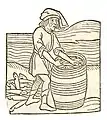 Buch IV, Kapitel 3. ..... Allec – Soupe de poisson
Buch IV, Kapitel 3. ..... Allec – Soupe de poisson Buch IV, Kapitel 56. ..... Mugil – Mugilidae
Buch IV, Kapitel 56. ..... Mugil – Mugilidae Page-titre ... »De lapidibus«
Page-titre ... »De lapidibus« Buch V, Kapitel 6. Allectorius – Pierre du foie du chapon
Buch V, Kapitel 6. Allectorius – Pierre du foie du chapon Buch V, Kapitel 12. Arena – Sable
Buch V, Kapitel 12. Arena – Sable Buch V, Kapitel 13. Argilla – Argile
Buch V, Kapitel 13. Argilla – Argile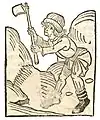 Buch V, Kapitel 16. Bol d'Arménie
Buch V, Kapitel 16. Bol d'Arménie Buch V, Kapitel 18. Aurum – Or
Buch V, Kapitel 18. Aurum – Or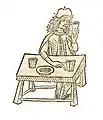 Buch V, Kapitel 20. Argentum – Argent
Buch V, Kapitel 20. Argentum – Argent Buch V, Kapitel 21. Argentum vivum – Mercure
Buch V, Kapitel 21. Argentum vivum – Mercure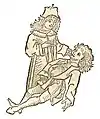 Buch V, Kapitel 24. Bezaar – Bézoard
Buch V, Kapitel 24. Bezaar – Bézoard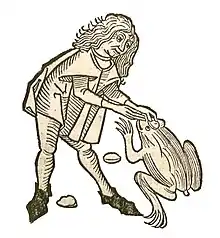 Buch V, Kapitel 27. ..... Borax – Crapaudine
Buch V, Kapitel 27. ..... Borax – Crapaudine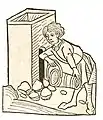 Buch V, Kapitel 30. ..... Calx – Oxyde de calcium
Buch V, Kapitel 30. ..... Calx – Oxyde de calcium Buch V, Kapitel 33. Celidonius – Pierre de l’estomac de l’hirondelle
Buch V, Kapitel 33. Celidonius – Pierre de l’estomac de l’hirondelle Buch V, Kapitel 35. Cerusa – Céruse
Buch V, Kapitel 35. Cerusa – Céruse Buch V, Kapitel 46. Cuprum – Cuivre
Buch V, Kapitel 46. Cuprum – Cuivre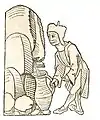 Buch V, Kapitel 101. Petroleum – Pétrole
Buch V, Kapitel 101. Petroleum – Pétrole Buch V, Kapitel 124. ..... Sal – Sel
Buch V, Kapitel 124. ..... Sal – Sel Buch V, Kapitel 130. Terra sigillata
Buch V, Kapitel 130. Terra sigillata Titelblatt zum Abschnitt Uroscopie
Titelblatt zum Abschnitt Uroscopie Feuille de clôture
Feuille de clôture
Littérature
- Brigitte Baumann, Helmut Baumann: Die Mainzer Kräuterbuch-Inkunabeln – „Herbarius Moguntinus“ (1484) – „Gart der Gesundheit“ (1485) – „Hortus Sanitatis“ (1491). Wissenschaftshistorische Untersuchung der drei Prototypen botanisch-medizinischer Literatur des Spätmittelalters. Hiersemann, Stuttgart 2010, (ISBN 978-3-7772-1020-9).
- Hermann Fischer: Mittelalterliche Pflanzenkunde. Verlag der Münchner Drucke, München 1929, S. 94–104.
- Gundolf Keil: Hortus sanitatis. In: Verfasserlexikon. 2. Auflage. Band 4, Sp. 154–164.
- Gundolf Keil: ‚Hortus sanitatis‘. In: Werner E. Gerabek, Bernhard D. Haage, Gundolf Keil, Wolfgang Wegner (Hrsg.): Enzyklopädie Medizingeschichte. De Gruyter, Berlin/New York 2005, (ISBN 3-11-015714-4), S. 618 f.
- Gundolf Keil: Hortus Sanitatis, Gart der Gesundheit, Gaerde der Sunthede. In: Elisabeth B. MacDougall (Hrsg.): Medieval Gardens. (= Dumbarton Oaks Colloquium on the history of landscape architecture. Band 9). Washington, D.C. 1986.
- Arnold C. Klebs: Herbal facts and thoughts. L’art ancien S. A., Lugano 1925.
- Arnold C. Klebs: Incunabula scientifica et medica. Brügge 1938 (Nachdruck Olms, Hildesheim 2004), S. 172.
Notes et références
- Matthaeus (Silvaticus) Moretus. Liber pandectarum medicinae médecine omnia simplicia continens. Bologne 1474 Bibliothèque d'État de Bavière Matthaeus (Silvaticus) Moretus. Liber pandectarum medicinae. Strasbourg vers 1480 (Digitalisat)
- Vincentius. "Speculum naturale." Strasbourg 1481. Volume I (Digitalisat) Volume II (Digitalisat)
- Brigitte Baumann, Helmut Baumann: Die Mainzer Kräuterbuch-Inkunabeln – „Herbarius Moguntinus“ (1484) – „Gart der Gesundheit“ (1485) – „Hortus Sanitatis“ (1491). Wissenschaftshistorische Untersuchung der drei Prototypen botanisch-medizinischer Literatur des Spätmittelalters. Hiersemann, Stuttgart 2010, S. 182.
- Mayence. Jacob Meydenbach 1491 (Digitalisat)
- Strasbourg. 1497 anonyme > Avec des gravures sur bois de l'atelier de Hans Grüninger, qui ont également servi à illustrer le Liber de arte distillandi de simplicibus. Voir : Brigitte, Helmut Baumann: « Les incunables du livre à base de plantes de Mayence. » Hiersemann, Stuttgart 2010, pp. 238-239. f.v. Zglinicki pensait pouvoir attribuer cette estampe à l'atelier de Johann Prüss (1447-1510). (Friedrich v. Zglinicki: Uroscopy in the fine arts. An art and medical history study of urine inspection. Ernst Giebeler, Darmstadt 1982, (ISBN 3-921956-24-2), p. 60 f.)
- Strasbourg, Anonyme, vers 1500 (Digitalisat)
- Strasbourg après 1500
- Strasbourg 1517 (Digitalisat)
- Strasbourg. Apiarius 1536 (Digitalisat)
- Strasbourg 1529. Hans Grüninger 1 (Digitalisat)]
- Strasbourg 1529. Balthasar Beck. Jardin de la santé. au latin ... (Digitalisat)
- Strasbourg 1536. Mathias Apiarius. Jardin de la santé Zů Latin ... (Digitalisat) [https: // reader.digitale-sammlungen.de//de/fs1/object/display/bsb10196463_00002.html (numérisé)]
- Francfort 1556. Hermann Gülfferich. Gart der Gesundtheyt zu Latin ... (Digitalisat)
- Mainz. Jacob Meydenbach 1491 (Digitalisat)